Corporate Finance: Evaluating Employee Superannuation Choices
VerifiedAdded on 2023/06/12
|13
|2756
|489
Report
AI Summary
This report explores the factors that tertiary sector employees consider when making superannuation investment choices in Australia. It discusses defined benefit plans versus investment choice plans, highlighting factors like returns, risk, employee income, retirement age, and investment knowledge. The report also addresses issues that affect the decision-making process, such as the time value of money, taxes, and inflation, and how these elements can impact investment returns and financial well-being. It concludes that employees must carefully consider these factors to make informed decisions about their retirement plans, and to understand the potential impact of market conditions and economic factors.

Corporate Finance Assignment
5/23/2018
5/23/2018
Secure Best Marks with AI Grader
Need help grading? Try our AI Grader for instant feedback on your assignments.
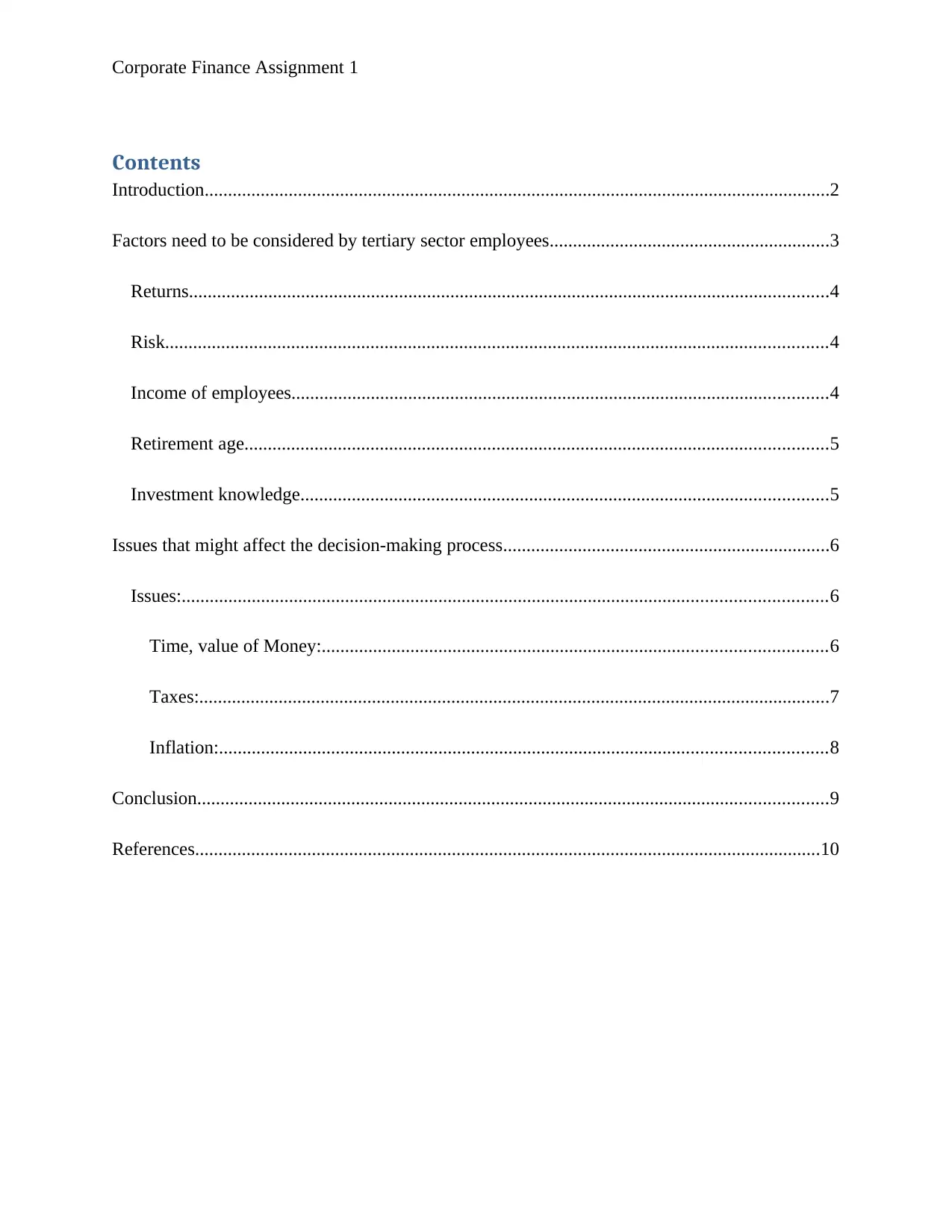
Corporate Finance Assignment 1
Contents
Introduction......................................................................................................................................2
Factors need to be considered by tertiary sector employees............................................................3
Returns.........................................................................................................................................4
Risk..............................................................................................................................................4
Income of employees...................................................................................................................4
Retirement age.............................................................................................................................5
Investment knowledge.................................................................................................................5
Issues that might affect the decision-making process......................................................................6
Issues:..........................................................................................................................................6
Time, value of Money:............................................................................................................6
Taxes:.......................................................................................................................................7
Inflation:..................................................................................................................................8
Conclusion.......................................................................................................................................9
References......................................................................................................................................10
Contents
Introduction......................................................................................................................................2
Factors need to be considered by tertiary sector employees............................................................3
Returns.........................................................................................................................................4
Risk..............................................................................................................................................4
Income of employees...................................................................................................................4
Retirement age.............................................................................................................................5
Investment knowledge.................................................................................................................5
Issues that might affect the decision-making process......................................................................6
Issues:..........................................................................................................................................6
Time, value of Money:............................................................................................................6
Taxes:.......................................................................................................................................7
Inflation:..................................................................................................................................8
Conclusion.......................................................................................................................................9
References......................................................................................................................................10
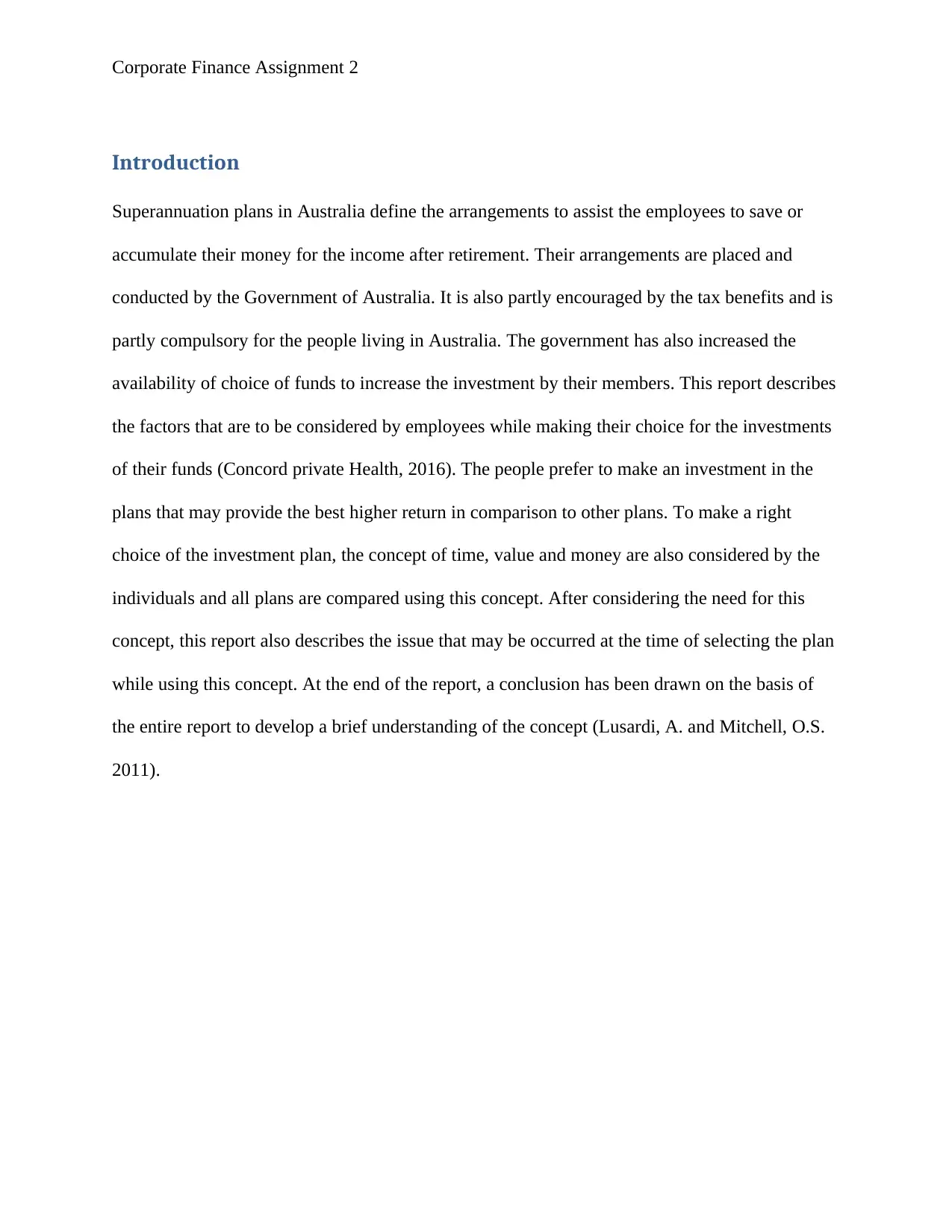
Corporate Finance Assignment 2
Introduction
Superannuation plans in Australia define the arrangements to assist the employees to save or
accumulate their money for the income after retirement. Their arrangements are placed and
conducted by the Government of Australia. It is also partly encouraged by the tax benefits and is
partly compulsory for the people living in Australia. The government has also increased the
availability of choice of funds to increase the investment by their members. This report describes
the factors that are to be considered by employees while making their choice for the investments
of their funds (Concord private Health, 2016). The people prefer to make an investment in the
plans that may provide the best higher return in comparison to other plans. To make a right
choice of the investment plan, the concept of time, value and money are also considered by the
individuals and all plans are compared using this concept. After considering the need for this
concept, this report also describes the issue that may be occurred at the time of selecting the plan
while using this concept. At the end of the report, a conclusion has been drawn on the basis of
the entire report to develop a brief understanding of the concept (Lusardi, A. and Mitchell, O.S.
2011).
Introduction
Superannuation plans in Australia define the arrangements to assist the employees to save or
accumulate their money for the income after retirement. Their arrangements are placed and
conducted by the Government of Australia. It is also partly encouraged by the tax benefits and is
partly compulsory for the people living in Australia. The government has also increased the
availability of choice of funds to increase the investment by their members. This report describes
the factors that are to be considered by employees while making their choice for the investments
of their funds (Concord private Health, 2016). The people prefer to make an investment in the
plans that may provide the best higher return in comparison to other plans. To make a right
choice of the investment plan, the concept of time, value and money are also considered by the
individuals and all plans are compared using this concept. After considering the need for this
concept, this report also describes the issue that may be occurred at the time of selecting the plan
while using this concept. At the end of the report, a conclusion has been drawn on the basis of
the entire report to develop a brief understanding of the concept (Lusardi, A. and Mitchell, O.S.
2011).
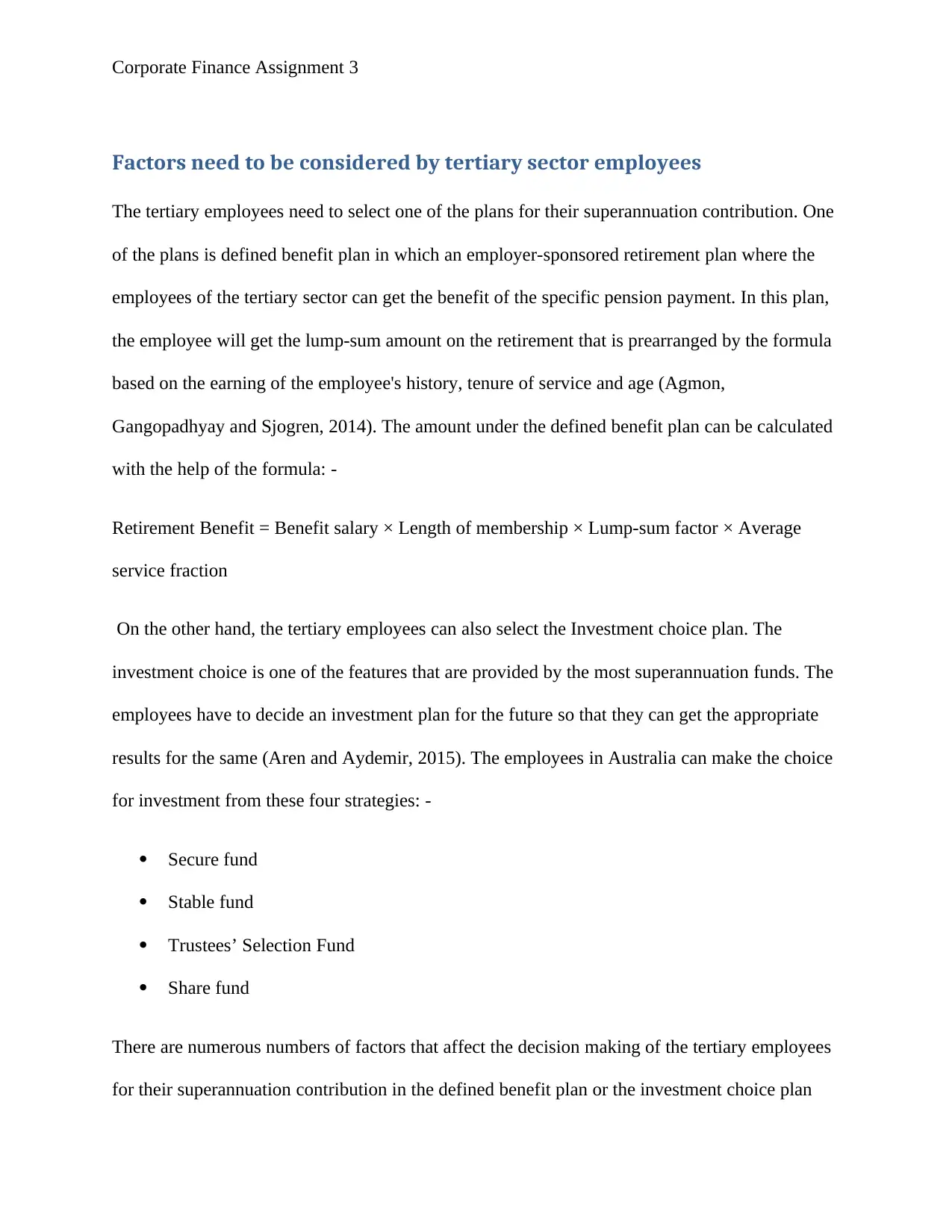
Corporate Finance Assignment 3
Factors need to be considered by tertiary sector employees
The tertiary employees need to select one of the plans for their superannuation contribution. One
of the plans is defined benefit plan in which an employer-sponsored retirement plan where the
employees of the tertiary sector can get the benefit of the specific pension payment. In this plan,
the employee will get the lump-sum amount on the retirement that is prearranged by the formula
based on the earning of the employee's history, tenure of service and age (Agmon,
Gangopadhyay and Sjogren, 2014). The amount under the defined benefit plan can be calculated
with the help of the formula: -
Retirement Benefit = Benefit salary × Length of membership × Lump-sum factor × Average
service fraction
On the other hand, the tertiary employees can also select the Investment choice plan. The
investment choice is one of the features that are provided by the most superannuation funds. The
employees have to decide an investment plan for the future so that they can get the appropriate
results for the same (Aren and Aydemir, 2015). The employees in Australia can make the choice
for investment from these four strategies: -
Secure fund
Stable fund
Trustees’ Selection Fund
Share fund
There are numerous numbers of factors that affect the decision making of the tertiary employees
for their superannuation contribution in the defined benefit plan or the investment choice plan
Factors need to be considered by tertiary sector employees
The tertiary employees need to select one of the plans for their superannuation contribution. One
of the plans is defined benefit plan in which an employer-sponsored retirement plan where the
employees of the tertiary sector can get the benefit of the specific pension payment. In this plan,
the employee will get the lump-sum amount on the retirement that is prearranged by the formula
based on the earning of the employee's history, tenure of service and age (Agmon,
Gangopadhyay and Sjogren, 2014). The amount under the defined benefit plan can be calculated
with the help of the formula: -
Retirement Benefit = Benefit salary × Length of membership × Lump-sum factor × Average
service fraction
On the other hand, the tertiary employees can also select the Investment choice plan. The
investment choice is one of the features that are provided by the most superannuation funds. The
employees have to decide an investment plan for the future so that they can get the appropriate
results for the same (Aren and Aydemir, 2015). The employees in Australia can make the choice
for investment from these four strategies: -
Secure fund
Stable fund
Trustees’ Selection Fund
Share fund
There are numerous numbers of factors that affect the decision making of the tertiary employees
for their superannuation contribution in the defined benefit plan or the investment choice plan
Secure Best Marks with AI Grader
Need help grading? Try our AI Grader for instant feedback on your assignments.
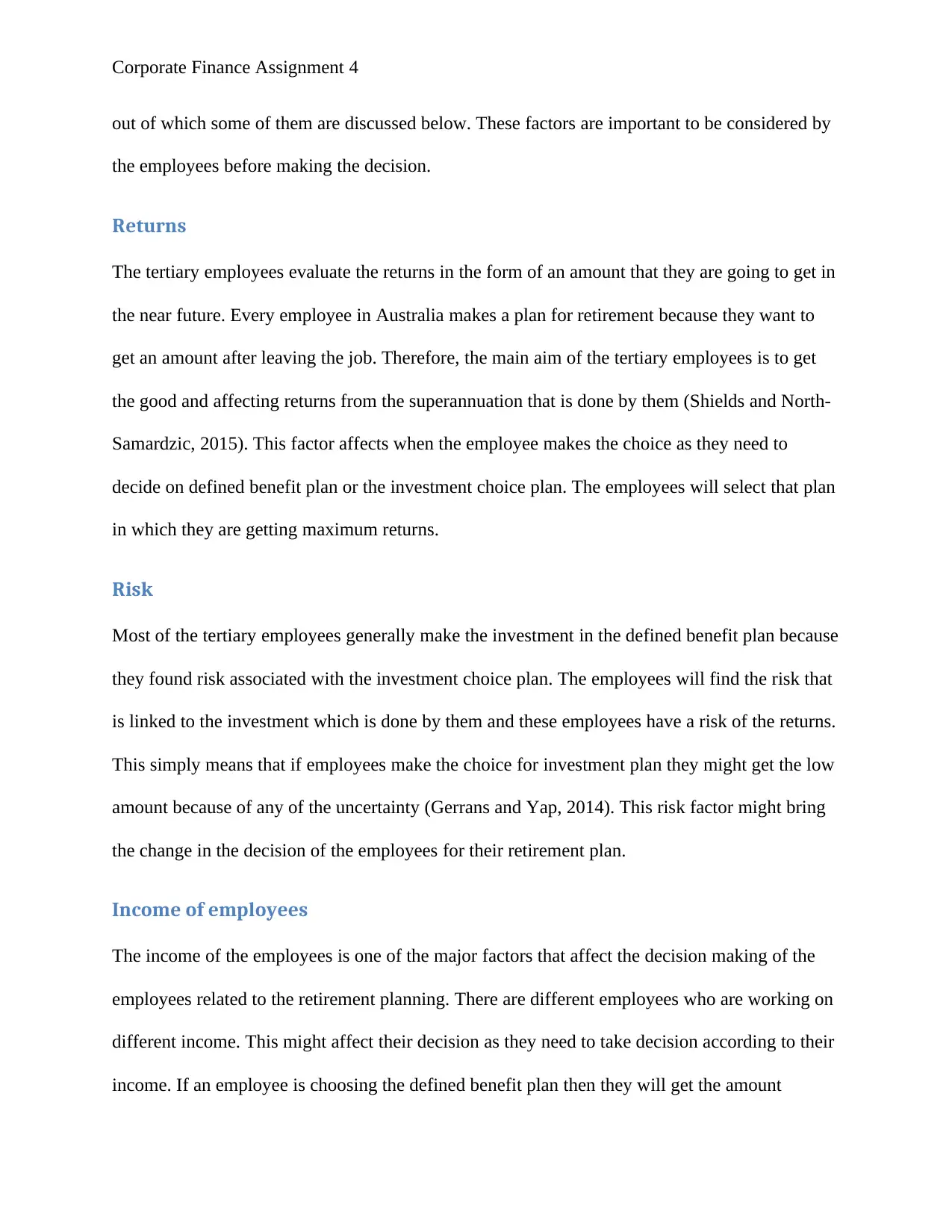
Corporate Finance Assignment 4
out of which some of them are discussed below. These factors are important to be considered by
the employees before making the decision.
Returns
The tertiary employees evaluate the returns in the form of an amount that they are going to get in
the near future. Every employee in Australia makes a plan for retirement because they want to
get an amount after leaving the job. Therefore, the main aim of the tertiary employees is to get
the good and affecting returns from the superannuation that is done by them (Shields and North-
Samardzic, 2015). This factor affects when the employee makes the choice as they need to
decide on defined benefit plan or the investment choice plan. The employees will select that plan
in which they are getting maximum returns.
Risk
Most of the tertiary employees generally make the investment in the defined benefit plan because
they found risk associated with the investment choice plan. The employees will find the risk that
is linked to the investment which is done by them and these employees have a risk of the returns.
This simply means that if employees make the choice for investment plan they might get the low
amount because of any of the uncertainty (Gerrans and Yap, 2014). This risk factor might bring
the change in the decision of the employees for their retirement plan.
Income of employees
The income of the employees is one of the major factors that affect the decision making of the
employees related to the retirement planning. There are different employees who are working on
different income. This might affect their decision as they need to take decision according to their
income. If an employee is choosing the defined benefit plan then they will get the amount
out of which some of them are discussed below. These factors are important to be considered by
the employees before making the decision.
Returns
The tertiary employees evaluate the returns in the form of an amount that they are going to get in
the near future. Every employee in Australia makes a plan for retirement because they want to
get an amount after leaving the job. Therefore, the main aim of the tertiary employees is to get
the good and affecting returns from the superannuation that is done by them (Shields and North-
Samardzic, 2015). This factor affects when the employee makes the choice as they need to
decide on defined benefit plan or the investment choice plan. The employees will select that plan
in which they are getting maximum returns.
Risk
Most of the tertiary employees generally make the investment in the defined benefit plan because
they found risk associated with the investment choice plan. The employees will find the risk that
is linked to the investment which is done by them and these employees have a risk of the returns.
This simply means that if employees make the choice for investment plan they might get the low
amount because of any of the uncertainty (Gerrans and Yap, 2014). This risk factor might bring
the change in the decision of the employees for their retirement plan.
Income of employees
The income of the employees is one of the major factors that affect the decision making of the
employees related to the retirement planning. There are different employees who are working on
different income. This might affect their decision as they need to take decision according to their
income. If an employee is choosing the defined benefit plan then they will get the amount
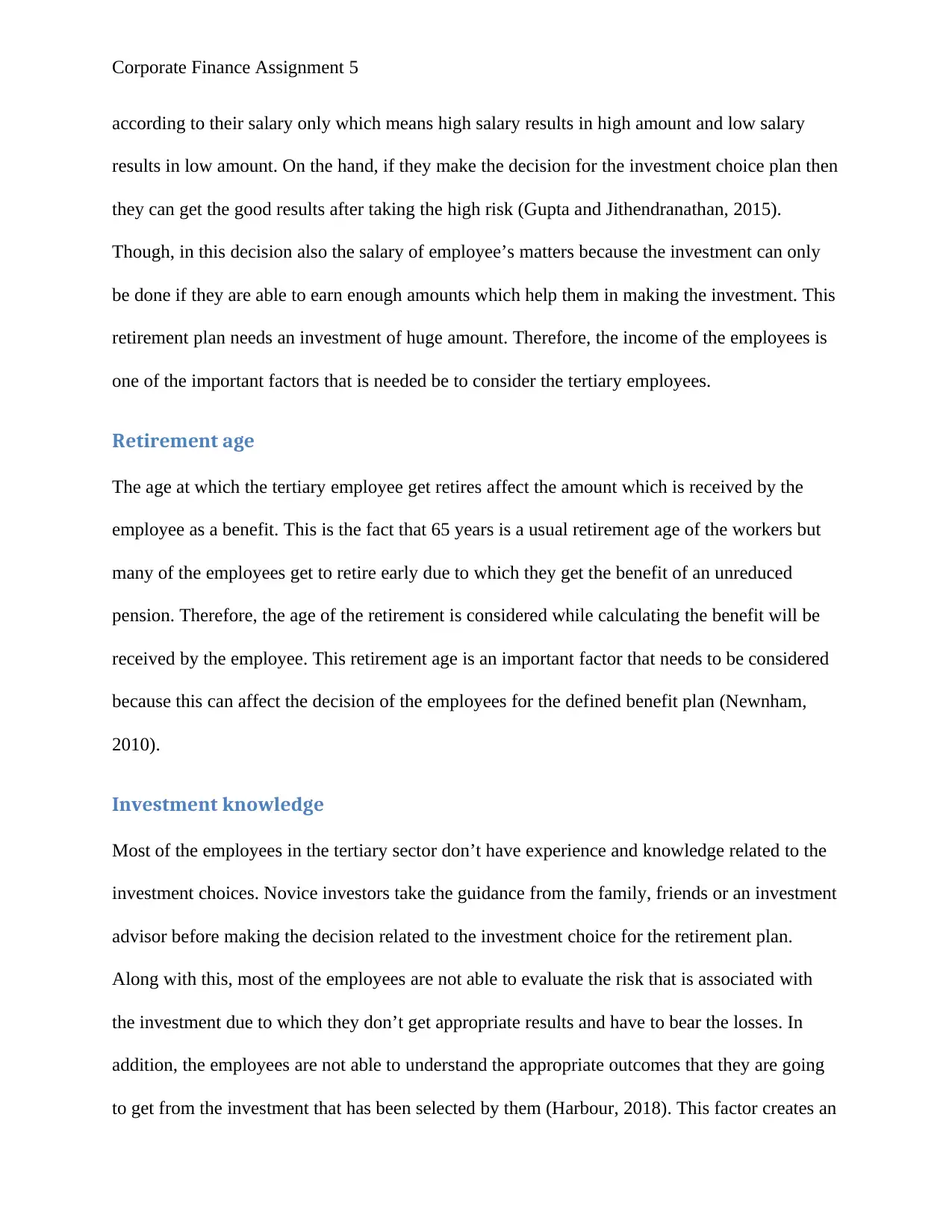
Corporate Finance Assignment 5
according to their salary only which means high salary results in high amount and low salary
results in low amount. On the hand, if they make the decision for the investment choice plan then
they can get the good results after taking the high risk (Gupta and Jithendranathan, 2015).
Though, in this decision also the salary of employee’s matters because the investment can only
be done if they are able to earn enough amounts which help them in making the investment. This
retirement plan needs an investment of huge amount. Therefore, the income of the employees is
one of the important factors that is needed be to consider the tertiary employees.
Retirement age
The age at which the tertiary employee get retires affect the amount which is received by the
employee as a benefit. This is the fact that 65 years is a usual retirement age of the workers but
many of the employees get to retire early due to which they get the benefit of an unreduced
pension. Therefore, the age of the retirement is considered while calculating the benefit will be
received by the employee. This retirement age is an important factor that needs to be considered
because this can affect the decision of the employees for the defined benefit plan (Newnham,
2010).
Investment knowledge
Most of the employees in the tertiary sector don’t have experience and knowledge related to the
investment choices. Novice investors take the guidance from the family, friends or an investment
advisor before making the decision related to the investment choice for the retirement plan.
Along with this, most of the employees are not able to evaluate the risk that is associated with
the investment due to which they don’t get appropriate results and have to bear the losses. In
addition, the employees are not able to understand the appropriate outcomes that they are going
to get from the investment that has been selected by them (Harbour, 2018). This factor creates an
according to their salary only which means high salary results in high amount and low salary
results in low amount. On the hand, if they make the decision for the investment choice plan then
they can get the good results after taking the high risk (Gupta and Jithendranathan, 2015).
Though, in this decision also the salary of employee’s matters because the investment can only
be done if they are able to earn enough amounts which help them in making the investment. This
retirement plan needs an investment of huge amount. Therefore, the income of the employees is
one of the important factors that is needed be to consider the tertiary employees.
Retirement age
The age at which the tertiary employee get retires affect the amount which is received by the
employee as a benefit. This is the fact that 65 years is a usual retirement age of the workers but
many of the employees get to retire early due to which they get the benefit of an unreduced
pension. Therefore, the age of the retirement is considered while calculating the benefit will be
received by the employee. This retirement age is an important factor that needs to be considered
because this can affect the decision of the employees for the defined benefit plan (Newnham,
2010).
Investment knowledge
Most of the employees in the tertiary sector don’t have experience and knowledge related to the
investment choices. Novice investors take the guidance from the family, friends or an investment
advisor before making the decision related to the investment choice for the retirement plan.
Along with this, most of the employees are not able to evaluate the risk that is associated with
the investment due to which they don’t get appropriate results and have to bear the losses. In
addition, the employees are not able to understand the appropriate outcomes that they are going
to get from the investment that has been selected by them (Harbour, 2018). This factor creates an
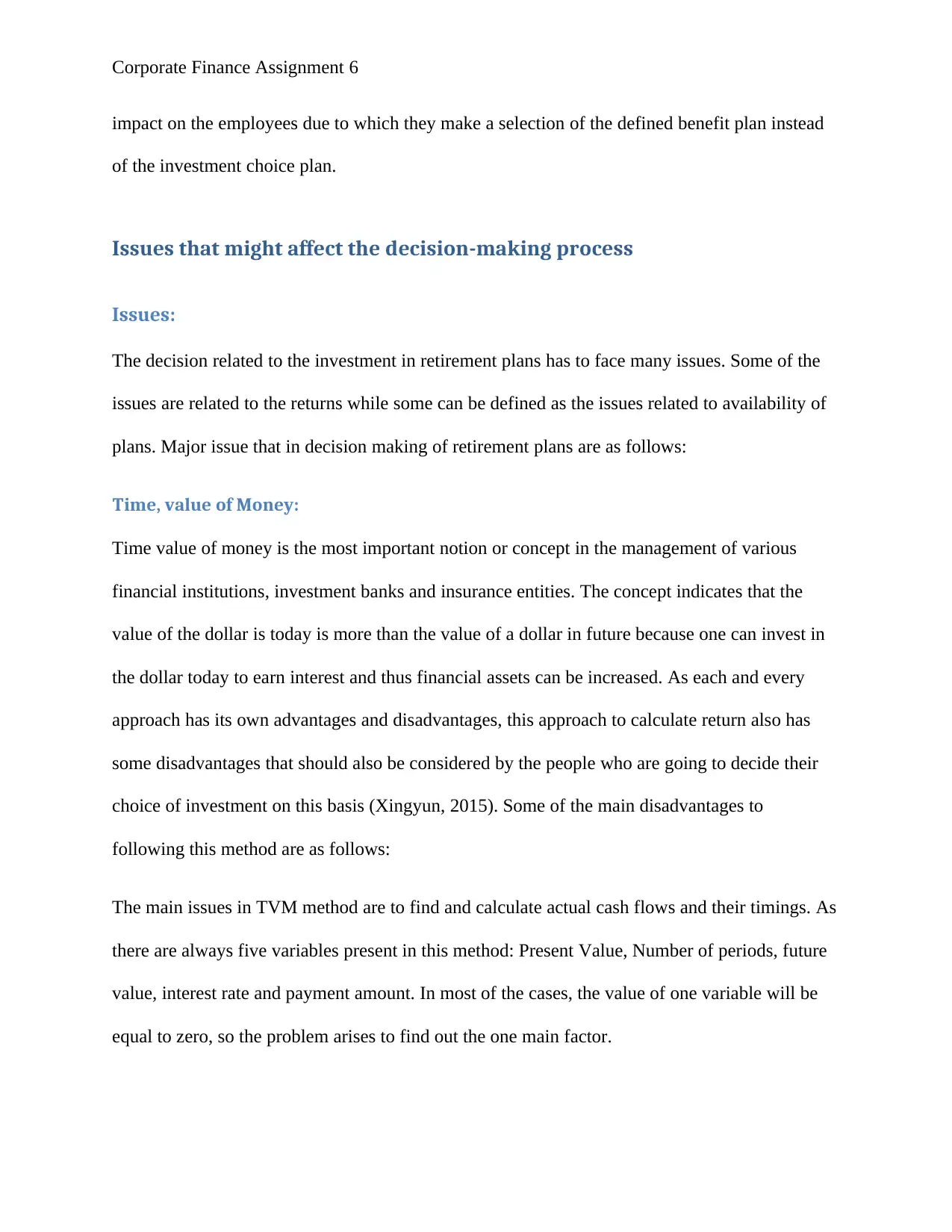
Corporate Finance Assignment 6
impact on the employees due to which they make a selection of the defined benefit plan instead
of the investment choice plan.
Issues that might affect the decision-making process
Issues:
The decision related to the investment in retirement plans has to face many issues. Some of the
issues are related to the returns while some can be defined as the issues related to availability of
plans. Major issue that in decision making of retirement plans are as follows:
Time, value of Money:
Time value of money is the most important notion or concept in the management of various
financial institutions, investment banks and insurance entities. The concept indicates that the
value of the dollar is today is more than the value of a dollar in future because one can invest in
the dollar today to earn interest and thus financial assets can be increased. As each and every
approach has its own advantages and disadvantages, this approach to calculate return also has
some disadvantages that should also be considered by the people who are going to decide their
choice of investment on this basis (Xingyun, 2015). Some of the main disadvantages to
following this method are as follows:
The main issues in TVM method are to find and calculate actual cash flows and their timings. As
there are always five variables present in this method: Present Value, Number of periods, future
value, interest rate and payment amount. In most of the cases, the value of one variable will be
equal to zero, so the problem arises to find out the one main factor.
impact on the employees due to which they make a selection of the defined benefit plan instead
of the investment choice plan.
Issues that might affect the decision-making process
Issues:
The decision related to the investment in retirement plans has to face many issues. Some of the
issues are related to the returns while some can be defined as the issues related to availability of
plans. Major issue that in decision making of retirement plans are as follows:
Time, value of Money:
Time value of money is the most important notion or concept in the management of various
financial institutions, investment banks and insurance entities. The concept indicates that the
value of the dollar is today is more than the value of a dollar in future because one can invest in
the dollar today to earn interest and thus financial assets can be increased. As each and every
approach has its own advantages and disadvantages, this approach to calculate return also has
some disadvantages that should also be considered by the people who are going to decide their
choice of investment on this basis (Xingyun, 2015). Some of the main disadvantages to
following this method are as follows:
The main issues in TVM method are to find and calculate actual cash flows and their timings. As
there are always five variables present in this method: Present Value, Number of periods, future
value, interest rate and payment amount. In most of the cases, the value of one variable will be
equal to zero, so the problem arises to find out the one main factor.
Paraphrase This Document
Need a fresh take? Get an instant paraphrase of this document with our AI Paraphraser
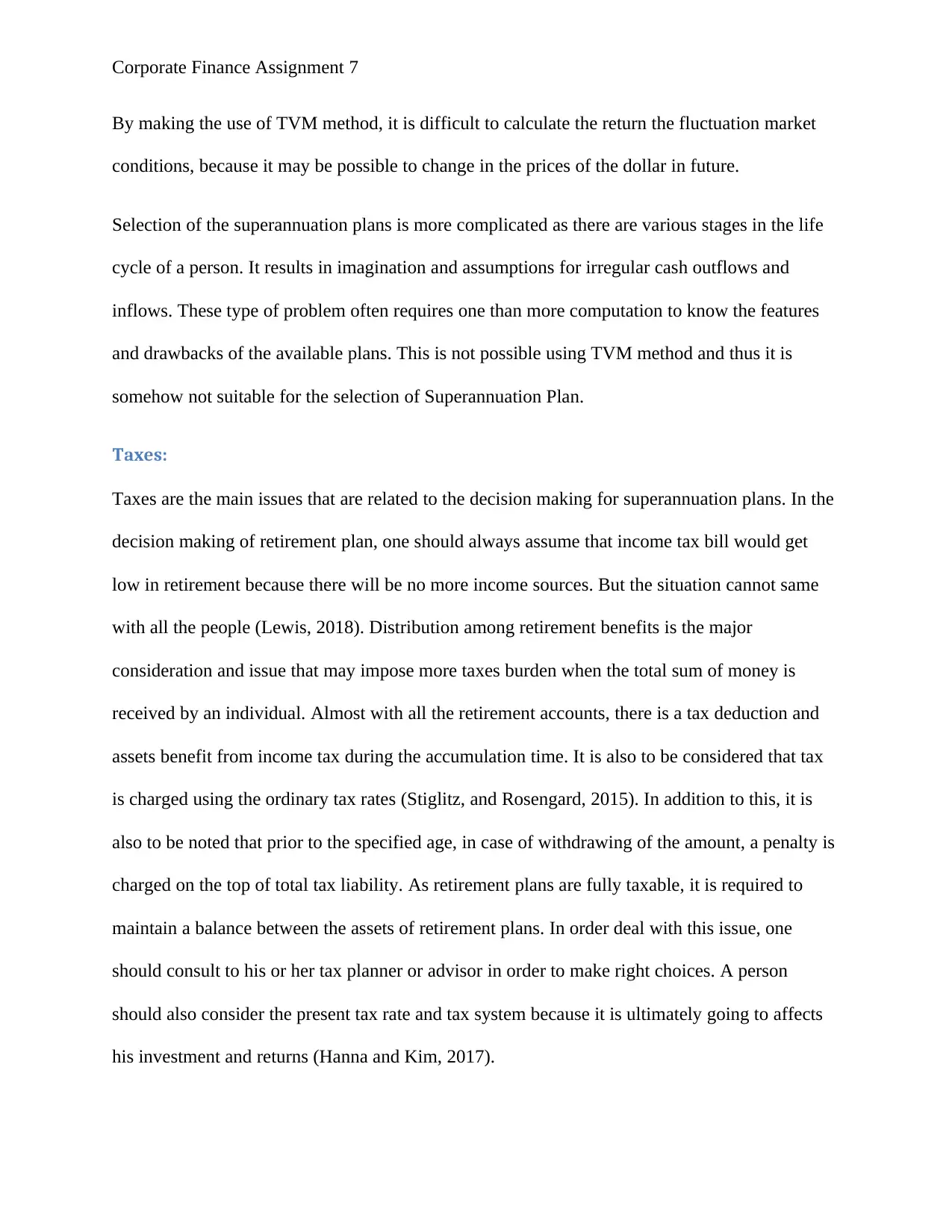
Corporate Finance Assignment 7
By making the use of TVM method, it is difficult to calculate the return the fluctuation market
conditions, because it may be possible to change in the prices of the dollar in future.
Selection of the superannuation plans is more complicated as there are various stages in the life
cycle of a person. It results in imagination and assumptions for irregular cash outflows and
inflows. These type of problem often requires one than more computation to know the features
and drawbacks of the available plans. This is not possible using TVM method and thus it is
somehow not suitable for the selection of Superannuation Plan.
Taxes:
Taxes are the main issues that are related to the decision making for superannuation plans. In the
decision making of retirement plan, one should always assume that income tax bill would get
low in retirement because there will be no more income sources. But the situation cannot same
with all the people (Lewis, 2018). Distribution among retirement benefits is the major
consideration and issue that may impose more taxes burden when the total sum of money is
received by an individual. Almost with all the retirement accounts, there is a tax deduction and
assets benefit from income tax during the accumulation time. It is also to be considered that tax
is charged using the ordinary tax rates (Stiglitz, and Rosengard, 2015). In addition to this, it is
also to be noted that prior to the specified age, in case of withdrawing of the amount, a penalty is
charged on the top of total tax liability. As retirement plans are fully taxable, it is required to
maintain a balance between the assets of retirement plans. In order deal with this issue, one
should consult to his or her tax planner or advisor in order to make right choices. A person
should also consider the present tax rate and tax system because it is ultimately going to affects
his investment and returns (Hanna and Kim, 2017).
By making the use of TVM method, it is difficult to calculate the return the fluctuation market
conditions, because it may be possible to change in the prices of the dollar in future.
Selection of the superannuation plans is more complicated as there are various stages in the life
cycle of a person. It results in imagination and assumptions for irregular cash outflows and
inflows. These type of problem often requires one than more computation to know the features
and drawbacks of the available plans. This is not possible using TVM method and thus it is
somehow not suitable for the selection of Superannuation Plan.
Taxes:
Taxes are the main issues that are related to the decision making for superannuation plans. In the
decision making of retirement plan, one should always assume that income tax bill would get
low in retirement because there will be no more income sources. But the situation cannot same
with all the people (Lewis, 2018). Distribution among retirement benefits is the major
consideration and issue that may impose more taxes burden when the total sum of money is
received by an individual. Almost with all the retirement accounts, there is a tax deduction and
assets benefit from income tax during the accumulation time. It is also to be considered that tax
is charged using the ordinary tax rates (Stiglitz, and Rosengard, 2015). In addition to this, it is
also to be noted that prior to the specified age, in case of withdrawing of the amount, a penalty is
charged on the top of total tax liability. As retirement plans are fully taxable, it is required to
maintain a balance between the assets of retirement plans. In order deal with this issue, one
should consult to his or her tax planner or advisor in order to make right choices. A person
should also consider the present tax rate and tax system because it is ultimately going to affects
his investment and returns (Hanna and Kim, 2017).
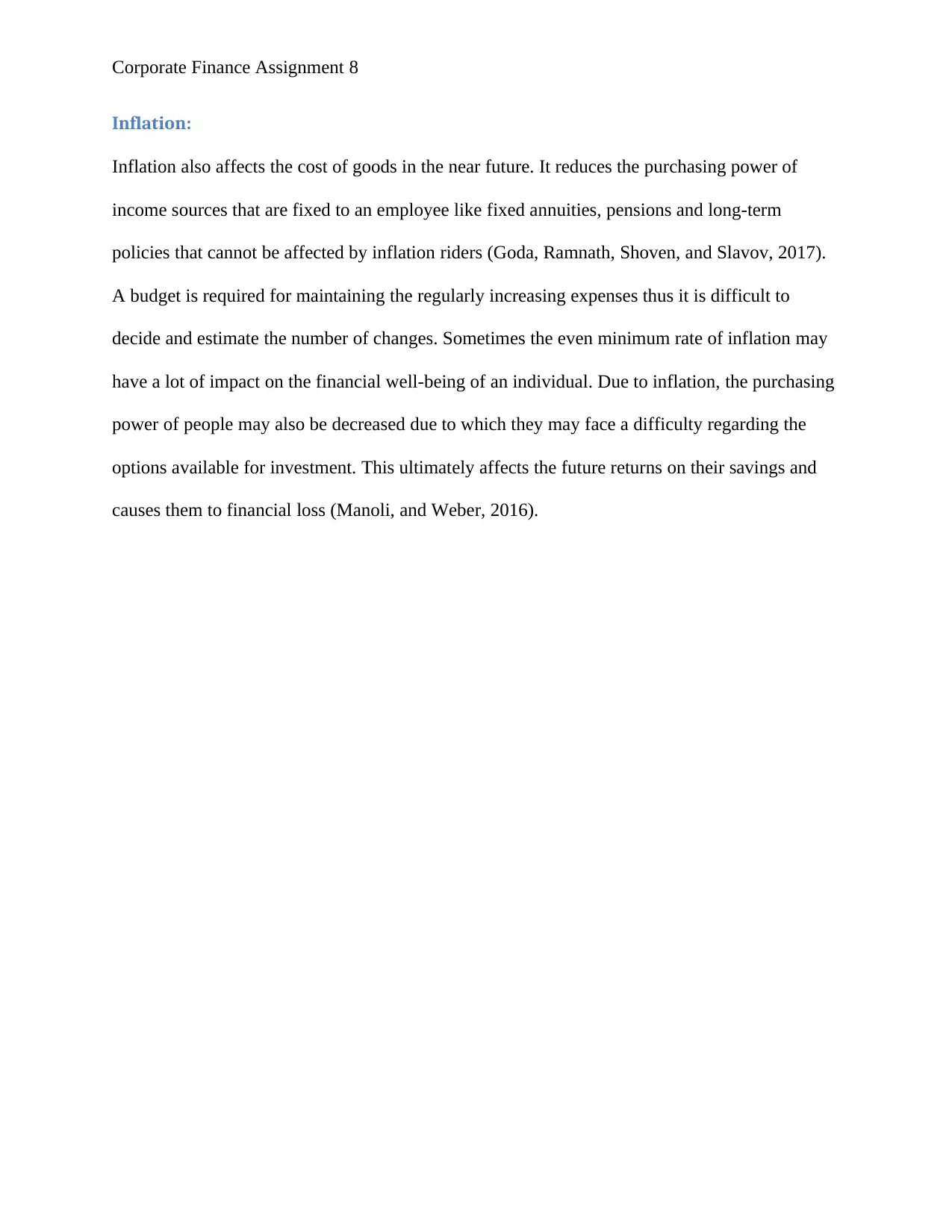
Corporate Finance Assignment 8
Inflation:
Inflation also affects the cost of goods in the near future. It reduces the purchasing power of
income sources that are fixed to an employee like fixed annuities, pensions and long-term
policies that cannot be affected by inflation riders (Goda, Ramnath, Shoven, and Slavov, 2017).
A budget is required for maintaining the regularly increasing expenses thus it is difficult to
decide and estimate the number of changes. Sometimes the even minimum rate of inflation may
have a lot of impact on the financial well-being of an individual. Due to inflation, the purchasing
power of people may also be decreased due to which they may face a difficulty regarding the
options available for investment. This ultimately affects the future returns on their savings and
causes them to financial loss (Manoli, and Weber, 2016).
Inflation:
Inflation also affects the cost of goods in the near future. It reduces the purchasing power of
income sources that are fixed to an employee like fixed annuities, pensions and long-term
policies that cannot be affected by inflation riders (Goda, Ramnath, Shoven, and Slavov, 2017).
A budget is required for maintaining the regularly increasing expenses thus it is difficult to
decide and estimate the number of changes. Sometimes the even minimum rate of inflation may
have a lot of impact on the financial well-being of an individual. Due to inflation, the purchasing
power of people may also be decreased due to which they may face a difficulty regarding the
options available for investment. This ultimately affects the future returns on their savings and
causes them to financial loss (Manoli, and Weber, 2016).
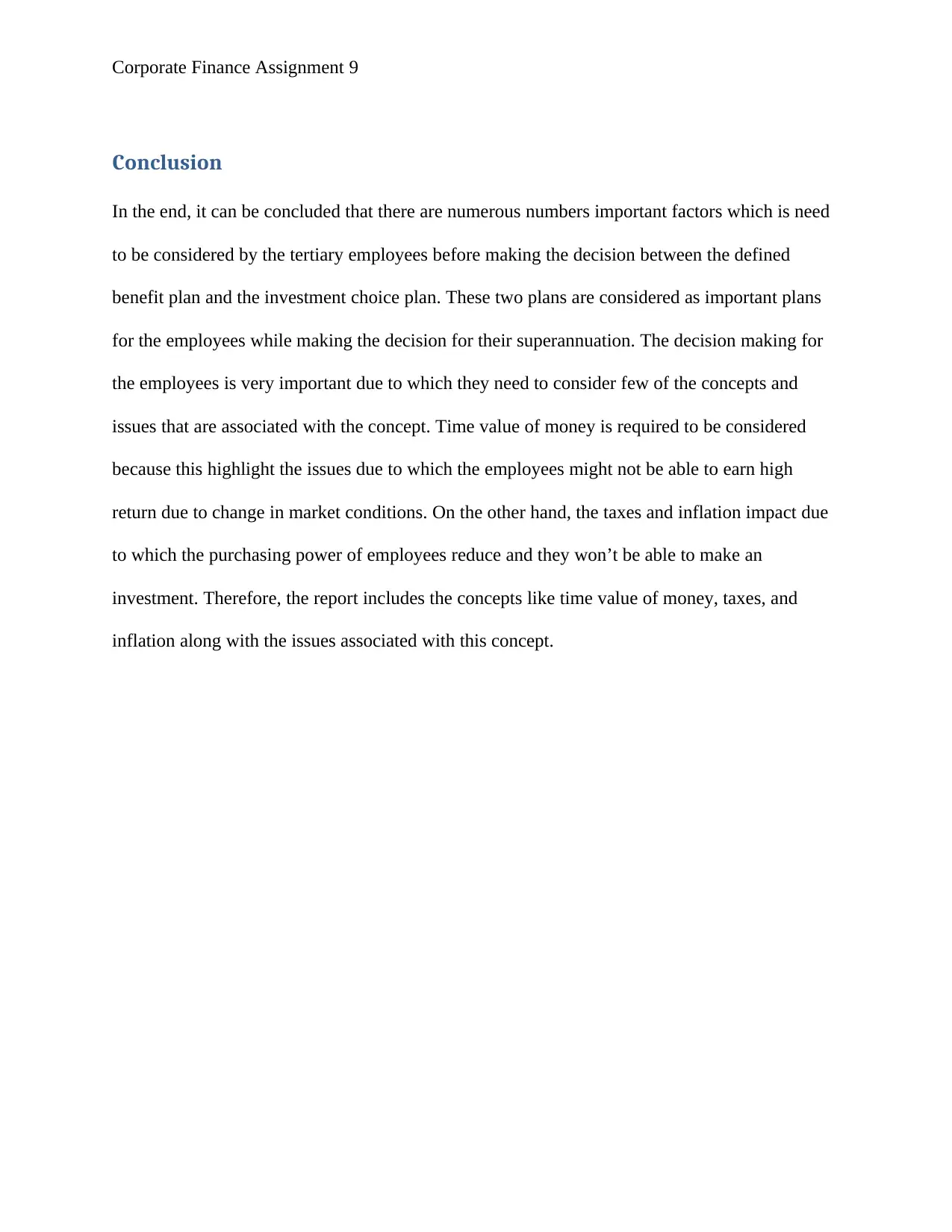
Corporate Finance Assignment 9
Conclusion
In the end, it can be concluded that there are numerous numbers important factors which is need
to be considered by the tertiary employees before making the decision between the defined
benefit plan and the investment choice plan. These two plans are considered as important plans
for the employees while making the decision for their superannuation. The decision making for
the employees is very important due to which they need to consider few of the concepts and
issues that are associated with the concept. Time value of money is required to be considered
because this highlight the issues due to which the employees might not be able to earn high
return due to change in market conditions. On the other hand, the taxes and inflation impact due
to which the purchasing power of employees reduce and they won’t be able to make an
investment. Therefore, the report includes the concepts like time value of money, taxes, and
inflation along with the issues associated with this concept.
Conclusion
In the end, it can be concluded that there are numerous numbers important factors which is need
to be considered by the tertiary employees before making the decision between the defined
benefit plan and the investment choice plan. These two plans are considered as important plans
for the employees while making the decision for their superannuation. The decision making for
the employees is very important due to which they need to consider few of the concepts and
issues that are associated with the concept. Time value of money is required to be considered
because this highlight the issues due to which the employees might not be able to earn high
return due to change in market conditions. On the other hand, the taxes and inflation impact due
to which the purchasing power of employees reduce and they won’t be able to make an
investment. Therefore, the report includes the concepts like time value of money, taxes, and
inflation along with the issues associated with this concept.
Secure Best Marks with AI Grader
Need help grading? Try our AI Grader for instant feedback on your assignments.
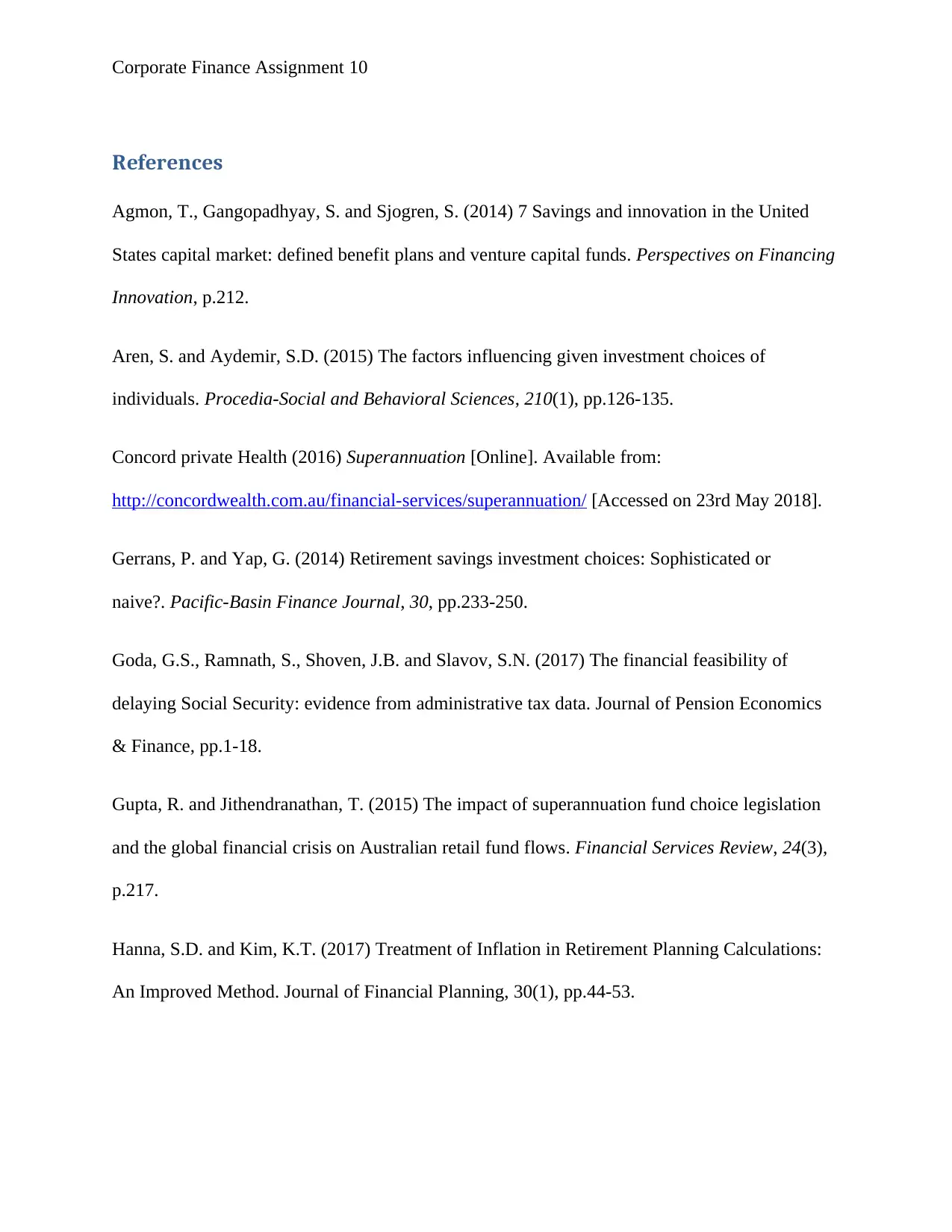
Corporate Finance Assignment 10
References
Agmon, T., Gangopadhyay, S. and Sjogren, S. (2014) 7 Savings and innovation in the United
States capital market: defined benefit plans and venture capital funds. Perspectives on Financing
Innovation, p.212.
Aren, S. and Aydemir, S.D. (2015) The factors influencing given investment choices of
individuals. Procedia-Social and Behavioral Sciences, 210(1), pp.126-135.
Concord private Health (2016) Superannuation [Online]. Available from:
http://concordwealth.com.au/financial-services/superannuation/ [Accessed on 23rd May 2018].
Gerrans, P. and Yap, G. (2014) Retirement savings investment choices: Sophisticated or
naive?. Pacific-Basin Finance Journal, 30, pp.233-250.
Goda, G.S., Ramnath, S., Shoven, J.B. and Slavov, S.N. (2017) The financial feasibility of
delaying Social Security: evidence from administrative tax data. Journal of Pension Economics
& Finance, pp.1-18.
Gupta, R. and Jithendranathan, T. (2015) The impact of superannuation fund choice legislation
and the global financial crisis on Australian retail fund flows. Financial Services Review, 24(3),
p.217.
Hanna, S.D. and Kim, K.T. (2017) Treatment of Inflation in Retirement Planning Calculations:
An Improved Method. Journal of Financial Planning, 30(1), pp.44-53.
References
Agmon, T., Gangopadhyay, S. and Sjogren, S. (2014) 7 Savings and innovation in the United
States capital market: defined benefit plans and venture capital funds. Perspectives on Financing
Innovation, p.212.
Aren, S. and Aydemir, S.D. (2015) The factors influencing given investment choices of
individuals. Procedia-Social and Behavioral Sciences, 210(1), pp.126-135.
Concord private Health (2016) Superannuation [Online]. Available from:
http://concordwealth.com.au/financial-services/superannuation/ [Accessed on 23rd May 2018].
Gerrans, P. and Yap, G. (2014) Retirement savings investment choices: Sophisticated or
naive?. Pacific-Basin Finance Journal, 30, pp.233-250.
Goda, G.S., Ramnath, S., Shoven, J.B. and Slavov, S.N. (2017) The financial feasibility of
delaying Social Security: evidence from administrative tax data. Journal of Pension Economics
& Finance, pp.1-18.
Gupta, R. and Jithendranathan, T. (2015) The impact of superannuation fund choice legislation
and the global financial crisis on Australian retail fund flows. Financial Services Review, 24(3),
p.217.
Hanna, S.D. and Kim, K.T. (2017) Treatment of Inflation in Retirement Planning Calculations:
An Improved Method. Journal of Financial Planning, 30(1), pp.44-53.
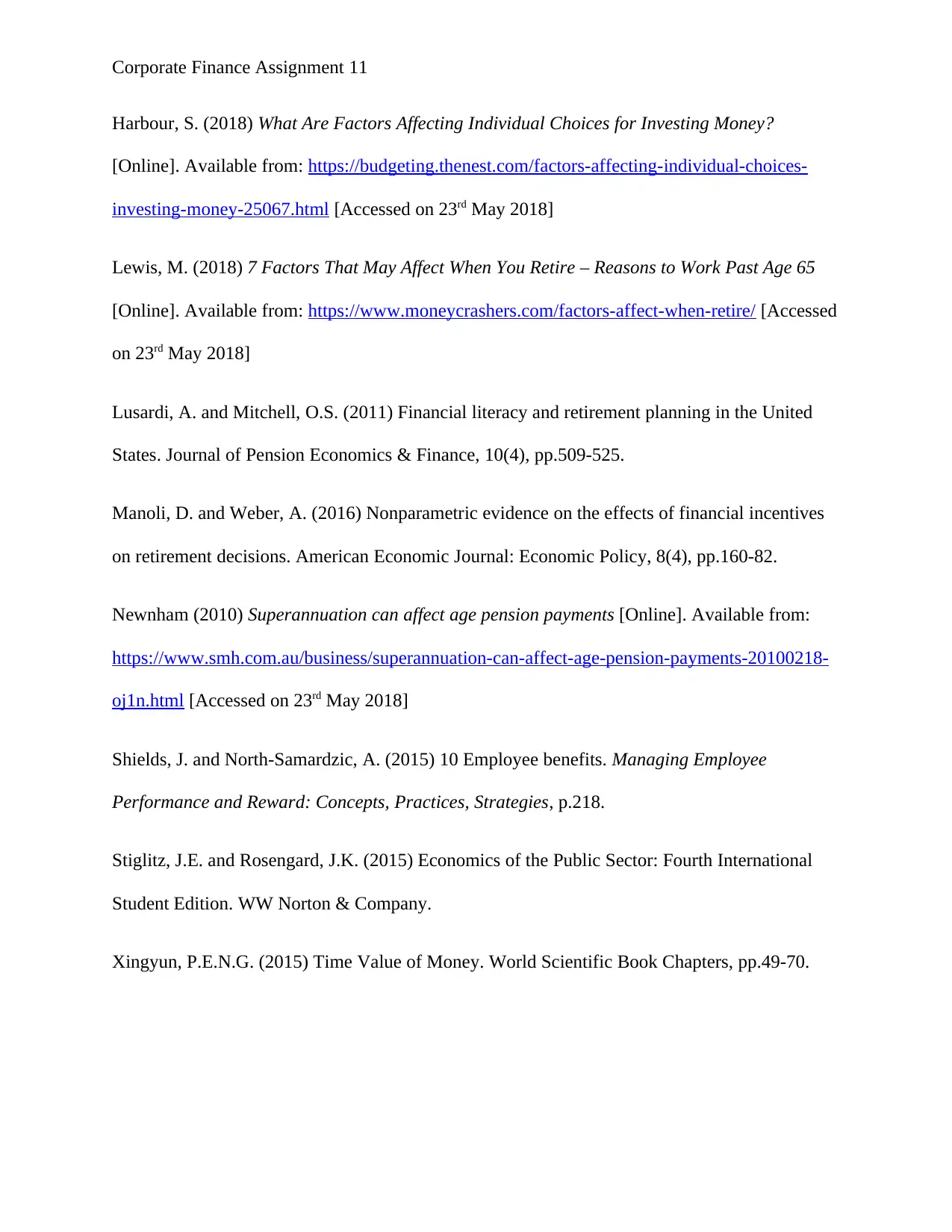
Corporate Finance Assignment 11
Harbour, S. (2018) What Are Factors Affecting Individual Choices for Investing Money?
[Online]. Available from: https://budgeting.thenest.com/factors-affecting-individual-choices-
investing-money-25067.html [Accessed on 23rd May 2018]
Lewis, M. (2018) 7 Factors That May Affect When You Retire – Reasons to Work Past Age 65
[Online]. Available from: https://www.moneycrashers.com/factors-affect-when-retire/ [Accessed
on 23rd May 2018]
Lusardi, A. and Mitchell, O.S. (2011) Financial literacy and retirement planning in the United
States. Journal of Pension Economics & Finance, 10(4), pp.509-525.
Manoli, D. and Weber, A. (2016) Nonparametric evidence on the effects of financial incentives
on retirement decisions. American Economic Journal: Economic Policy, 8(4), pp.160-82.
Newnham (2010) Superannuation can affect age pension payments [Online]. Available from:
https://www.smh.com.au/business/superannuation-can-affect-age-pension-payments-20100218-
oj1n.html [Accessed on 23rd May 2018]
Shields, J. and North-Samardzic, A. (2015) 10 Employee benefits. Managing Employee
Performance and Reward: Concepts, Practices, Strategies, p.218.
Stiglitz, J.E. and Rosengard, J.K. (2015) Economics of the Public Sector: Fourth International
Student Edition. WW Norton & Company.
Xingyun, P.E.N.G. (2015) Time Value of Money. World Scientific Book Chapters, pp.49-70.
Harbour, S. (2018) What Are Factors Affecting Individual Choices for Investing Money?
[Online]. Available from: https://budgeting.thenest.com/factors-affecting-individual-choices-
investing-money-25067.html [Accessed on 23rd May 2018]
Lewis, M. (2018) 7 Factors That May Affect When You Retire – Reasons to Work Past Age 65
[Online]. Available from: https://www.moneycrashers.com/factors-affect-when-retire/ [Accessed
on 23rd May 2018]
Lusardi, A. and Mitchell, O.S. (2011) Financial literacy and retirement planning in the United
States. Journal of Pension Economics & Finance, 10(4), pp.509-525.
Manoli, D. and Weber, A. (2016) Nonparametric evidence on the effects of financial incentives
on retirement decisions. American Economic Journal: Economic Policy, 8(4), pp.160-82.
Newnham (2010) Superannuation can affect age pension payments [Online]. Available from:
https://www.smh.com.au/business/superannuation-can-affect-age-pension-payments-20100218-
oj1n.html [Accessed on 23rd May 2018]
Shields, J. and North-Samardzic, A. (2015) 10 Employee benefits. Managing Employee
Performance and Reward: Concepts, Practices, Strategies, p.218.
Stiglitz, J.E. and Rosengard, J.K. (2015) Economics of the Public Sector: Fourth International
Student Edition. WW Norton & Company.
Xingyun, P.E.N.G. (2015) Time Value of Money. World Scientific Book Chapters, pp.49-70.

Corporate Finance Assignment 12
1 out of 13
Related Documents
Your All-in-One AI-Powered Toolkit for Academic Success.
+13062052269
info@desklib.com
Available 24*7 on WhatsApp / Email
![[object Object]](/_next/static/media/star-bottom.7253800d.svg)
Unlock your academic potential
© 2024 | Zucol Services PVT LTD | All rights reserved.





